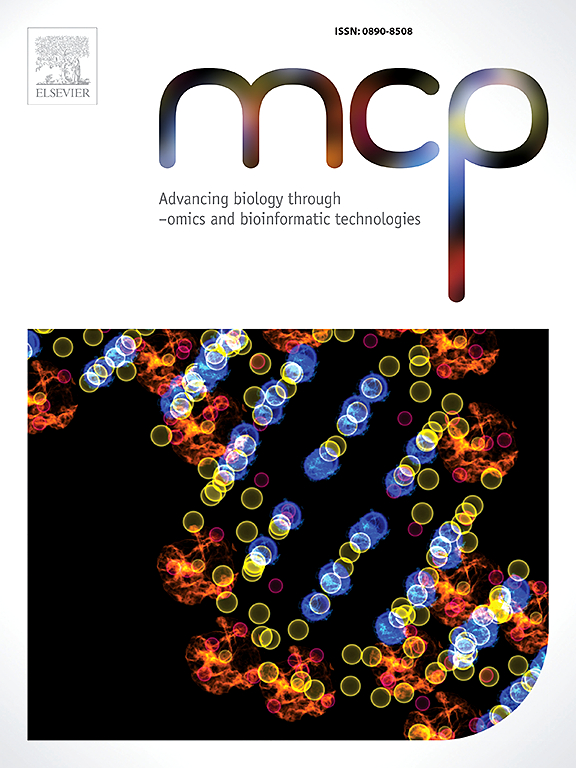Copy number variations in urine cell-free DNA from bladder neoplasm patients
IF 3
3区 生物学
Q3 BIOCHEMICAL RESEARCH METHODS
引用次数: 0
Abstract
Bladder cancer is a common malignancy, and its diagnosis is based on invasive procedures such as cystoscopy. Genetic aberrations play an important role in the development of many diseases, including bladder cancer. As a result, identifying the genetic basis of a disease can provide useful information for early diagnosis and therapy. Cell-free DNA (cfDNA) offers a non-invasive approach to extract genetic information, which could be valuable for establishing the genetic cause of bladder cancer. In this study, we analyzed copy number variations (CNV) in urine cfDNA from 20 patients, with cystoscopy confirmed bladder cancer, sequenced by next-generation sequencing (NGS) and their CNV examined using the whole genome sequence. Statistical analysis of the carcinoma samples included Wilcoxon and Chi-square tests (p ≤ 0.005). Different patterns in CNV were identified in Chromosomes 1, 2, 3, 5, 6, 8, 9, 10, 11, 12, 17, 19, and 20 with the chromosome cytobands showing significant difference in variation patterns in patient parameters, such as smoking habit, number of tumors, grade of the tumors, and invasiveness. The genes that exhibited distinct CNV in each chromosomal cytoband have been associated with the development and progression of various cancers including bladder cancer indicating the clinical significance of CNVs as a useful tool for disease diagnosis. Therefore, this study demonstrates that by using NGS, CNV in urine cfDNA can provide valuable information on the state of blader cancer which can be further utilized to investigate therapies or early diagnosis.

膀胱肿瘤患者尿无细胞DNA拷贝数的变化。
膀胱癌是一种常见的恶性肿瘤,其诊断是基于侵入性手术,如膀胱镜检查。遗传畸变在包括膀胱癌在内的许多疾病的发展中起着重要作用。因此,确定疾病的遗传基础可以为早期诊断和治疗提供有用的信息。无细胞DNA (cfDNA)提供了一种非侵入性的方法来提取遗传信息,这对于确定膀胱癌的遗传原因可能有价值。在这项研究中,我们分析了20例膀胱镜检查确诊的膀胱癌患者尿液cfDNA的拷贝数变异(CNV),采用下一代测序(NGS)测序,并使用全基因组序列检测其CNV。肿瘤样本的统计学分析采用Wilcoxon检验和卡方检验(p≤0.005)。在第1、2、3、5、6、8、9、10、11、12、17、19和20号染色体上发现了不同的CNV模式,染色体细胞带在患者吸烟习惯、肿瘤数量、肿瘤分级和侵袭性等参数上的变异模式存在显著差异。在每个染色体细胞带中表现出不同CNV的基因与包括膀胱癌在内的各种癌症的发生和进展相关,这表明CNV作为疾病诊断的有用工具具有临床意义。因此,本研究表明,通过NGS,尿cfDNA中的CNV可以提供有关膀胱癌状态的有价值的信息,可进一步用于研究治疗或早期诊断。
本文章由计算机程序翻译,如有差异,请以英文原文为准。
求助全文
约1分钟内获得全文
求助全文
来源期刊

Molecular and Cellular Probes
生物-生化研究方法
CiteScore
6.80
自引率
0.00%
发文量
52
审稿时长
16 days
期刊介绍:
MCP - Advancing biology through–omics and bioinformatic technologies wants to capture outcomes from the current revolution in molecular technologies and sciences. The journal has broadened its scope and embraces any high quality research papers, reviews and opinions in areas including, but not limited to, molecular biology, cell biology, biochemistry, immunology, physiology, epidemiology, ecology, virology, microbiology, parasitology, genetics, evolutionary biology, genomics (including metagenomics), bioinformatics, proteomics, metabolomics, glycomics, and lipidomics. Submissions with a technology-driven focus on understanding normal biological or disease processes as well as conceptual advances and paradigm shifts are particularly encouraged. The Editors welcome fundamental or applied research areas; pre-submission enquiries about advanced draft manuscripts are welcomed. Top quality research and manuscripts will be fast-tracked.
 求助内容:
求助内容: 应助结果提醒方式:
应助结果提醒方式:


